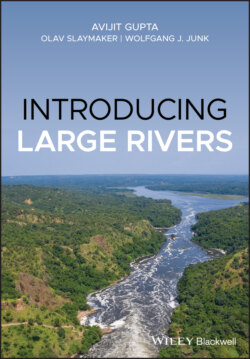Читать книгу Introducing Large Rivers - Avijit Gupta - Страница 18
2.5 Geological History of Large Rivers
ОглавлениеThe morphology and behaviour of a large river, as discussed, reflect structural control at several levels. The location and origin of the basin are commonly determined by creation of a new surface by plate collision or rifting or doming. The course of the river may follow an older geofracture or be fixed in places where it passes over controls such as a structural embayment. The character of the river changes where it crosses an upwarp transverse to its course or a regional pattern of faults as seen in the central part of the Amazon Basin near Manaus. The dimensions of a major river also change when it passes through steep gorges separated by low-gradient alluvial basins. These variations not only modify the bedrock channel of the rivers, but they also influence valley sedimentation and give rise to variable riverine morphology, bar forms, and presence or absence of floodplains at the surface. Furthermore, in all cases, the new drainage basin needs to be large enough to maintain a major river and be located in a suitable hydrologic environment.
Large rivers vary in their size and age. Mobility of continental plates may result in plate destruction and size reduction or slow passage of the plate to a drier part of the Earth. Such developments modify or may even destroy a major river. In contrast, plates may increase in dimensions or reach more humid areas over time. Potter (1978) suggested that very big rivers may have been formed draining an enormous land mass consisting of welded cratonic blocks which carried at least one system of fold mountains and was well-watered.
The geological history of a major river therefore has a beginning and an end. The Mississippi is recognised to have been in existence since at least the Cretaceous because of a subsurface rock embayment located near its present confluence with the Ohio River mentioned earlier. The embayment is related to later Mississippi River fills and sediment of the Mississippi, dating back to the Jurassic period, has been found in the Gulf of Mexico. The embayment has been dated to late Precambrian (Ervin and McGinnis 1975). A large river therefore has been approximately in a place for nearly 300 million years or about 1/16th of the history of the Earth (Potter 1978). It is an old river, so are several others such as the Nile. The ancestral Nile has been associated with the ancient Pan-African orogenic events of about 550 million years ago or earlier. The river has been modified over time to its present appearance (Woodward et al. 2007 and references therein).
Not all major rivers have a similar long history. The present Amazon came into existence after the rise of the Andes in the Miocene. There was an older drainage system earlier, flowing westward and probably related to the African Plate before the opening of the South Atlantic. The Ganga and Brahmaputra, two major Himalayan rivers, probably came into existence in the Miocene after the formation of the Himalaya Mountains following the collision of the Indian Plate with the Eurasian Plate. There may have been an earlier drainage system, but it has been drastically modified, and the present drainage network has evolved over time. For example, the drainage of the western Himalaya was modified through a set of river captures, changing the direction of flow of the tributaries of the Ganga and Indus (Burbank 1992; Clift and Blusztajn 2005). It is believed that earlier the Sông Hóng (Red River) drainage net included the former upper Changjiang (Yangtze), Mekong, Salween and Tsanpo. The earlier upper drainage of the Sông Hóng then disintegrated to form the headwaters of these separate major rivers (Brookfield 1998). Robinson et al. (2014) have opined that the present Brahmaputra system has changed from the old Yarlung Tsanpo–Brahmaputra–Irrawaddy linkage to the present drainage via river capture and tectonic movements, around 18 Ma ago, and finally was captured by the Bay of Bengal system of the Upper Brahmaputra by the Lohit and newer Himalayan rivers (Licht and Giosan accepted for publication).
A river system may be terminated by other events such as a large-scale marine invasion, a new tectonic deformation, outpouring of lava or continental glaciation (Potter 1978). Tectonic, geomorphic and climatic processes may also modify an earlier drainage. The collision of the Indian and Eurasian Plates resulted in crustal shortening, differential shear and rotation associated with the rise of the Himalaya. An existing river may disappear through river capture, climate change resulting in a drier environment, or deformation due to plate tectonics. The change may affect almost the entire basin or only part of the drainage system. Potter (1978) has described rivers which were an assemblage of parts as having a composite age. Some rivers may persist in spite of major interruptions to experience over a long existence. The major rivers, their deltas, and offshore trenches underwent multiple changes during the Pleistocene. Goodbred Jr (2003) has traced the series of modifications that the Ganga River underwent since Marine Isotope Stage 3 (MIS 3, 58 000 years ago), mainly due to climate change.
